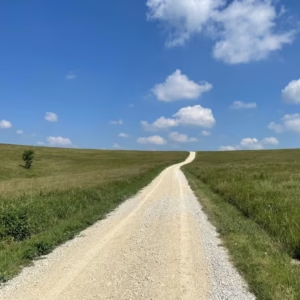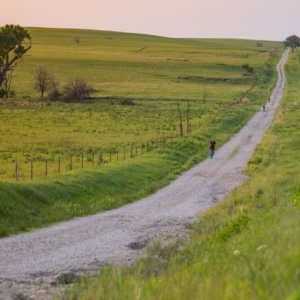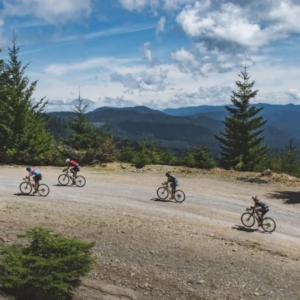Gravel touring is rapidly gaining popularity among adventure enthusiasts. This exciting activity merges the challenges of cycling with the exhilaration of exploring diverse terrains. Selecting the right bike is crucial for ensuring a comfortable and enjoyable experience on your journey. So, what is a good gravel touring bike? This comprehensive guide will cover all the essential factors you need to consider to make an informed choice, helping you embark on your gravel touring adventures with confidence.
Understanding Gravel Touring
What is gravel touring?
Gravel touring is an exciting form of long-distance cycling that takes place on a variety of terrains, including gravel roads, dirt paths, and occasional stretches of pavement. Unlike road biking, which is primarily focused on smooth surfaces and speed, gravel touring emphasizes versatility, endurance, and the spirit of exploration. This style of cycling allows riders to venture off the beaten path, discovering scenic routes and remote areas that are often inaccessible by traditional road bikes.
How is it different from other cycling styles?
Gravel touring bikes are specifically designed to handle rough and varied terrain, offering enhanced stability and comfort compared to standard road bikes. These bikes typically feature wider tires for better traction and shock absorption, allowing riders to navigate uneven surfaces with ease. Additionally, gravel touring bikes strike a balance between weight and agility, making them lighter and more maneuverable than mountain bikes while still providing the necessary robustness for mixed surfaces. This combination makes gravel touring bikes ideal for riders who want to experience the thrill of diverse landscapes without compromising on comfort.
Common terrains for gravel touring
Gravel touring often takes cyclists through dirt trails, forest roads, and unpaved paths, providing a rich variety of riding experiences. As riders traverse these terrains, they encounter uneven surfaces, rocky sections, and varying degrees of incline. This variability makes it essential to choose the right bike equipped with appropriate features for safety and performance. Factors such as tire width, frame geometry, and gearing play critical roles in ensuring a smooth and enjoyable ride across these diverse landscapes. By selecting a suitable gravel touring bike, cyclists can confidently tackle the challenges of different terrains while enjoying the freedom that comes with exploring the great outdoors.
Top Gravel Cycling Destinations in the U.S.
Touring Bike vs. Gravel Touring Bike

Touring Bikes
These bikes are specifically designed for long-distance travel on paved roads, as shown in the image above (left side). They prioritize comfort and stability, making them suitable for carrying heavy loads over extended journeys. Touring bikes often come equipped with racks and panniers, allowing riders to transport essential gear and supplies.
Gravel Touring Bikes
In contrast, gravel touring bikes are engineered for rough and mixed terrains. They blend durability, comfort, and adaptability, making them ideal for riding on gravel roads, dirt paths, and uneven surfaces. These bikes are perfect for those who seek adventure and exploration beyond traditional road cycling.
Key Differences
Frame Geometry: Gravel bikes feature a more relaxed frame geometry, which enhances control and stability on uneven surfaces. This design allows riders to navigate challenging terrain with greater ease and confidence.
Tire Width: Gravel touring bikes are equipped with wider tires that have specialized tread patterns for improved grip and traction. This contrasts with touring bikes, which typically have narrower, smoother tires designed for speed and efficiency on paved roads.
Gear Ratios: Gravel bikes offer a broader range of gear ratios to help tackle hills and off-road conditions effectively. This allows riders to shift smoothly through diverse terrains while touring bikes usually have gearing optimized for flat, paved routes.
Use Cases
Choose a touring bike for paved road trips where you plan to carry heavy luggage and prioritize comfort over rough terrain. Opt for a gravel touring bike if you’re looking to explore adventurous routes with unpredictable surfaces, as it will provide the versatility and stability needed for a variety of conditions.
Key Features of a Good Gravel Touring Bike
Frame Material
Aluminum: Aluminum frames are popular for their lightweight and affordable nature, making them a common choice for many cyclists. However, while they are great for speed and efficiency, they tend to be less comfortable on rough roads due to their rigidity, which can transmit more vibrations to the rider.
Steel: Steel frames are known for their durability and comfort. They can absorb shock well, making them ideal for long rides over uneven terrain. However, they are generally heavier than aluminum, which might be a consideration for those focused on weight savings.
Carbon: Carbon fiber frames are prized for their lightweight and shock-absorbing properties, providing an excellent balance of performance and comfort. However, they come with a higher price tag, making them less accessible for budget-conscious riders. Their ability to dampen vibrations makes them a favorite for gravel touring.
Titanium: Titanium frames offer a unique combination of strength, lightness, and comfort, making them a top choice for serious cyclists. They are highly durable and resistant to corrosion, but they are also the most expensive option. Titanium bikes are often seen as a long-term investment for avid riders.
Geometry and Fit
A good gravel touring bike should feature:
- Stable Geometry: A design optimized for stability is crucial for long rides, allowing riders to maintain control over extended distances and varied terrains.
- Proper Reach and Stack Measurements: These measurements ensure that the bike fits the rider comfortably, preventing fatigue during long rides. A well-fitted bike reduces strain on the back, shoulders, and arms.
- Long Wheelbase: A longer wheelbase enhances handling, providing better stability, especially when navigating rough or uneven surfaces. This design feature helps in maintaining balance and control during descents and turns.
Tires and Wheel Size
Tire Width: For gravel touring, tires in the range of 35–50 mm are ideal. This width provides the necessary grip and comfort, allowing for better performance on loose and uneven surfaces.
Wheel Size:
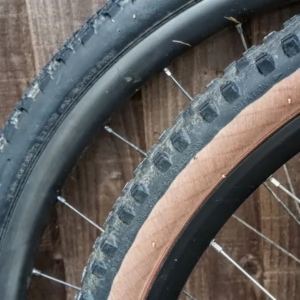
- 700c Wheels: These wheels are designed for speed, performing well on smooth surfaces. They are ideal for riders who prioritize efficiency on paved roads.
- 650b Wheels: Offering increased control and stability, 650b wheels are better suited for rough terrain. They provide a larger contact patch with the ground, enhancing traction and comfort on bumpy surfaces.
Tread Patterns: When choosing tires, consider the tread pattern:
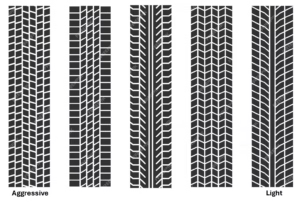
- Aggressive Tread: This is ideal for loose gravel and off-road conditions, providing the grip needed for challenging terrains.
- Larger gaps between blocks
- Deep grooves provide better grip on loose surfaces like gravel or mud
- A more rugged, uneven appearance
- Light Tread: Opt for this for smoother trails, as it reduces rolling resistance and enhances speed on firm surfaces.
- Smaller, tightly spaced blocks
- Shallower grooves for better efficiency on hard surfaces
- A sleeker, uniform design
Components and Gear
Drivetrain Options
Single Chainrings: Bikes equipped with single chainrings are designed for simplicity and ease of maintenance. This setup eliminates the complexity of front derailleurs, making it easier to shift gears. However, the trade-off is a more limited gear range, which may not be ideal for steep climbs or highly varied terrains.
Multiple Chainrings: In contrast, bikes with multiple chainrings provide a broader gear range, making them well-suited for diverse riding conditions. This setup allows for easier climbing and better adaptability on varied terrains, enabling riders to find the perfect gear for every situation, from steep hills to flat stretches.
Brakes
Disc Brakes: Disc brakes are favored for their superior stopping power, especially in wet or rough conditions. They provide consistent performance and better modulation, giving riders confidence and control when navigating challenging terrains.
Hydraulic vs. Mechanical Brakes: Hydraulic brakes offer smoother and more responsive braking performance, which can enhance the overall riding experience. However, they typically require more maintenance and can be more complex to service compared to mechanical brakes. Mechanical brakes, while easier to maintain, may not provide the same level of stopping power or feel.
Accessories and Compatibility
A well-equipped gravel touring bike should feature:
- Mounting Points: Adequate mounting points for racks, fenders, and bottle cages are essential for carrying gear and ensuring a comfortable ride. These features allow riders to customize their bikes to suit their touring needs.
- Bikepacking Compatibility: The bike should have enough room for bikepacking bags, ensuring that you can carry all necessary supplies for longer adventures. Additionally, compatibility with lights and GPS devices is crucial for safety and navigation, particularly on remote trails or during night rides.
Budget Considerations
Budget ($800–$1,500)
This price range is ideal for beginners who are just getting into gravel touring. Bikes in this category typically come with essential features that are suitable for casual riders. While they may lack some advanced components, they provide a solid introduction to the sport, allowing new cyclists to explore varied terrains without a hefty investment. If you’re wondering what is a good gravel touring bike in this range, look for models with basic drivetrain systems, standard brakes, and durable frames that can handle light touring and recreational rides.
Mid-Range ($1,500–$3,000)
Mid-range gravel touring bikes offer a balance of performance and durability, making them suitable for more serious cyclists. These bikes typically feature better components, such as improved gearing systems and enhanced braking options, contributing to a more enjoyable riding experience. If you’re asking yourself what is a good gravel touring bike at this price point, consider those with higher-quality materials that provide a good mix of weight savings and comfort. Riders can expect additional features like better tire clearance, more mounting options for accessories, and enhanced stability for tackling a variety of terrains.
High-End ($3,000+)
For serious riders who are committed to gravel touring, high-end bikes offer advanced features and premium materials. These bikes are designed with cutting-edge technology that enhances performance, such as lightweight carbon frames, sophisticated drivetrain systems, and high-quality disc brakes for superior stopping power. If you’re looking for answers to what is a good gravel touring bike in this category, you’ll find exceptional comfort and handling, with geometry tailored for long-distance rides and challenging terrains. High-end models often come with custom options and specialized components, allowing for a personalized touch that meets the demands of avid cyclists.
Maintenance and Care Tips
Regular Checks
Before each ride, it’s essential to conduct thorough inspections of your bike, focusing on critical components such as the tires, brakes, and drivetrain. Check the tire pressure to ensure optimal performance and safety, as properly inflated tires can greatly improve handling and reduce the risk of flats. Inspect the brakes for any wear on the pads and ensure they are functioning smoothly, as reliable brakes are crucial for safe riding, especially on varied terrains. Additionally, examine the drivetrain—this includes the chain, gears, and derailleurs—for any signs of wear or dirt accumulation. Regular checks will help you identify potential issues early, allowing you to address them before they affect your ride.
Cleaning
Keeping your bike clean is vital for maintaining its performance and longevity. After every ride, especially in muddy or wet conditions, take the time to clean your bike thoroughly. Use a gentle soap and a soft brush to remove dirt and grime from the frame, wheels, and components. Pay special attention to the drivetrain, as dirt buildup can lead to poor shifting and decreased efficiency. After cleaning, dry your bike completely to prevent moisture buildup, which can lead to rust and corrosion. Regular cleaning not only keeps your bike looking good but also enhances its overall performance by ensuring that all components function smoothly.
Storage
Proper storage is crucial for preserving the condition of your gravel touring bike. Always store your bike in a dry and sheltered place to protect it from the elements. Exposure to moisture can lead to rust and damage to metal parts, while harsh sunlight can degrade rubber components and paint. If possible, use a bike cover or hang your bike on a wall rack to keep it safe from dust and accidental bumps. Additionally, consider elevating the bike off the ground to prevent contact with moisture or debris. Proper storage habits will extend the lifespan of your bike and keep it ready for your next adventure.
Conclusion
In conclusion, gravel touring presents a thrilling opportunity for adventure enthusiasts to explore diverse terrains while enjoying the challenges of cycling. Selecting the right bike is essential for maximizing comfort and performance on these journeys. As you consider what is a good gravel touring bike, it’s important to evaluate various features, including frame material, geometry, and drivetrain options, which all play a significant role in your riding experience.
From budget-friendly options to high-end models, there are bikes tailored to suit every rider’s needs. Regular maintenance and care are crucial to ensure your bike remains in optimal condition, allowing you to tackle rugged paths confidently. Ultimately, understanding what is a good gravel touring bike will empower you to make informed choices, ensuring many enjoyable rides ahead as you discover the beauty of the great outdoors on your gravel touring adventures.
FAQs
- What is a gravel touring bike?
It’s a bike designed for long-distance cycling on mixed terrains. - How is a gravel touring bike different from a road bike?
Gravel bikes have wider tires and relaxed geometry for off-road conditions. - What tire width is best for gravel touring?
Tires between 35–50 mm provide the best grip and comfort. - Should I choose hydraulic or mechanical disc brakes?
Hydraulic brakes offer smoother performance but require more maintenance. - Is steel or aluminum better for a gravel bike frame?
Steel is more durable and comfortable, while aluminum is lighter and more affordable. - What accessories are essential for gravel touring?
Racks, fenders, bottle cages, and bike-packing bags are essential. - Can I use a road bike for gravel touring?
While possible, road bikes aren’t ideal due to their narrow tires and stiff frames. - Are 700c or 650b wheels better for gravel?
700c wheels are faster, while 650b wheels offer better control on rough terrain. - How much should I spend on a gravel touring bike?
Budget $800–$3,000, depending on your experience and needs.
Thanks for reading, for more interesting articles, visit our homepage.


